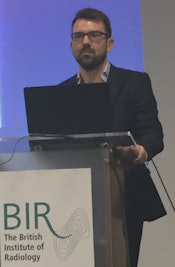
LONDON - Litigation claims involving radiology are on the rise, and it's vital to be prepared for the increasingly legalistic climate that lies ahead, an expert told delegates on 3 November at the annual congress of the British Institute of Radiology (BIR).
"I wonder if we are on course for another peak in claims, particularly in radiology, now with the Statutory Duty of Candour [a requirement for providers to be open and transparent with service users about their care and treatment, including when it goes wrong] proposals," said Dr. Oliver Hulson, consultant radiologist at Leeds Teaching Hospitals National Health Service (NHS) Trust, U.K.
 Dr. Oliver Hulson from Leeds.
Dr. Oliver Hulson from Leeds.He noted the Statutory Duty of Candour, which was published recently by the U.K. General Medical Council (GMC), looks set to generate interest in relation to claims.
"For example, if there’s a missed lung cancer on an x-ray from three years ago then there may have been a reporting discrepancy, but if the patient has lost weight, has a cough and is a smoker, then it could be argued that regardless of the chest x-ray findings they needed a CT scan anyway, because we miss up to 25% of lung cancers on chest x-ray," Hulson said. "We need to be cautious in attributing blame to a single x-ray at a single moment of time when in reality any perceived error is often multi-factorial."
He'd also like to see more guidance for radiologists, in particular in relation to the Duty of Candour statement. "In reality, nobody knows how this is going to play out on the shop floor," he added.
Key role of consent
Hulson also drew attention to the need for a two-step consent process.
"When patients come to my radiology department, I'd like them to be aware of the procedure they are having as well as the alternatives. I can perform a nephrostomy, but there's usually an alternative option that a nephrologist can do. However, to ensure fully informed consent, the patient needs to be aware of the alternatives," he said.
When patients arrive at the department, they should confirm the consent procedure and not be hearing it for the first time, he emphasized.
"There's a risk that once a patient is in the room, the pressure of the environment is that they feel they should go ahead with the procedure, so it is possible that we can be seen to coerce the patient."
Twenty years of claims
Hulson contacted the NHS Litigation Authority, who are obliged to provide settled but anonymous claims data under the Freedom of Information Act. Between 1995 and 2015, there were 791 radiology claims. He then examined the data for common themes, and found that nearly a third of claims related to delayed or incorrect cancer diagnoses, with chest x-ray or CT being mostly implicated, while MRI scans and ultrasound mammography constituted a smaller part of the total claims.
"Internationally, we've seen an increase in litigation claims across medicine but also in relation to radiology," Hulson said. "This is in part due to the growing demand on the service, and also because patients and the general public are becoming more aware about what radiology is and our role in medicine."
Below is a summary of the main claims data findings:
- 174 (29%) claims due to alleged missed, delayed, or incorrect cancer diagnosis
- Total claim costs equaled 15.6 million pounds (17.6 million euros) mean 79,587 pounds (89,647 euros, range 2,000 pounds to 1.69 million pounds; 2,252 euros to 1.9 million euros)
- 136 claims attributed to a delayed cancer diagnosis
- Mean length of delay of 113.4 days (range 60 to 2,190 days)
The claims of larger value usually related to cases whereby the patients needed a lot of further care in the future, for example if the patient became wheelchair bound, blind, or paraplegic, then these would be claims that settle to the tune of 1 million pounds (1.13 million euros) or more.
Interventional landscape
Hulson is an interventional radiologist, and the claims for this specialist area were small in number with 63 claims totaling 4.3 million pounds (4.8 million euros) with a mean claim amount of 63,110 pounds (71,087 euros; range 1,500 pounds to 379,666 pounds, 1,689 euros to 427,659 euros). There were 31 claims (49%) due to alleged substandard technique, 14 claims related to bleeding postprocedure (six related to anticoagulation), and eight claims related to an issue with consent for procedure.
"These claims in interventional radiology are relatively small but growing probably due to our increased workload. Also, we are more identifiable now than we were 10 to 20 years ago," he said, adding that claims related to substandard technique might reflect a need to address a training issue.
The nature of other claims included inappropriate procedure (2%), consent-related (12%), and smaller claims related to issues around wrong-site surgery (5%), guidewire left in situ (5%), and bleeding complications postprocedure (22%). The latter suggests a need to mitigate against effects of drugs including warfarin and aspirin as well as avoiding complications with them, according to Hulson.
With particular reference to anticoagulation drugs, he explained that different NHS trusts, or hospital groups, often have different guidance related to when to stop and restart anticoagulants and the difficulties associated with getting a grasp of a consensus approach. The British Society of Interventional Radiology (BSIR) also provides guidance, but this differs from European guidance, and now newer drugs are becoming available for the treatment of strokes, heart problems, and peripheral vascular disease. Plus, these drugs often have a longer half-life, he said.
"It's about awareness of radiologists in knowing how long these drugs act for. This finding has influenced my practice directly," Hulson said.
Interestingly, 75 (9.5%) claims related to injury in the radiology department, totaling 1.4 million pounds (1.6 million euros; mean 16,544 pounds, 18,635 euros) in the range of 500 pounds to 93,172 pounds (563 euros to 104,949 euros). Of these, 22 (29%) were due to a fall in the department with three claims settled relating to patients undergoing MRI despite having a pacemaker (4,116 pounds, 4,636 euros); an oxygen cylinder being present between the patient's legs (11,762 pounds, 13,428 euros), and one patient having not removed his hearing aids before the scan (1,200 pounds, 1,351 euros).
Peaks and troughs
Hulson has identified notable spikes in the history of claims data. In 1995 to 1996, for example, there was a change to compensation claims for motor vehicle accidents along the lines of "no-win-no-fee" culture.
In 2014 to 2015, the total amount provided to settle clinical negligence claims was 1.1 billion pounds (1.24 billion euros); 2011-2012 data showed that clinical negligence claims peaked at around 9,647 cases, and the following year there were 8,548 claims. Since the Clinical Negligence Scheme for Trusts (CNST) began in 1995, radiology has been the subject of 2,575 claims, worth 361 million pounds (406 million euros) compared with 46,382 claims in surgery (4.9 billion pounds, 5.5 billion euros), and 21,602 in obstetrics and gynecology (10.8 billion pounds, 12 billion euros).
"Surgery and medicine have the highest number of claims because they are high throughput and very patient-identifiable areas," Hulson reported. "The amount paid out in obstetric claims is particularly high because, for example with cerebral palsy, the courts factor in how much the child will demand in terms of care costs for their life, and this is usually tens of millions of pounds."
Compared with the U.S., the claims in the U.K. pale into insignificance, however they are growing, Hulson said. "I think they are growing faster here because litigation in the U.S. has been a problem for a long time. In some states, they are seeing claims fall due to a no-blame compensation scheme whereby compensation is given, but nobody is at fault, as well as an effort to cap legal costs for claims under $150,000 [169,000 euros]."



















